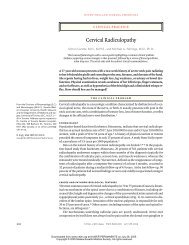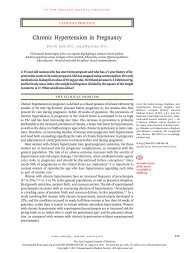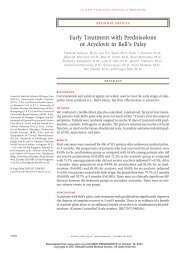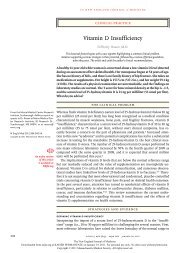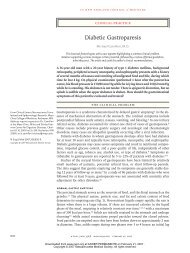Hypoparathyroidism - Q-Notes for Adult Medicine
Hypoparathyroidism - Q-Notes for Adult Medicine
Hypoparathyroidism - Q-Notes for Adult Medicine
You also want an ePaper? Increase the reach of your titles
YUMPU automatically turns print PDFs into web optimized ePapers that Google loves.
The new england journal of medicine<br />
Table 1. Pathophysiological Features of Disorders Considered in the Differential Diagnosis of <strong>Hypoparathyroidism</strong>.*<br />
Mechanism and Disorder Clinical Observations Reference<br />
Destruction or removal of parathyroid tissue, with inadequate secretory reserve remaining<br />
Postsurgical hypoparathyroidism Most common <strong>for</strong>m of hypoparathyroidism; can present years after surgery† Winer et al. 4<br />
Autoimmune hypoparathyroidism May be either isolated deficiency or combined with multiple endocrine deficiencies<br />
Radiation-induced destruction of parathyroid<br />
Very rare complication<br />
tissue<br />
Metastatic infiltration of the parathyroid<br />
glands<br />
Deposition of heavy metals in parathyroid<br />
tissue<br />
Several documented cases due to a variety of underlying primary tumors, but generally rare site <strong>for</strong> metastases<br />
Occurs as a result of excess iron in ≥10% of patients with thalassemia, usually in second decade of life,<br />
when other end-organ complications (liver and heart disease, diabetes, hypogonadism, and hypothyroidism)<br />
are present, and correlates with extent of iron overload; less frequent complication of hemochromatosis<br />
and very rare complication of copper accumulation in Wilson’s disease<br />
Reversible impairment of PTH secretion or PTH action with intact underlying secretory function<br />
Severe magnesium depletion Associated with chronic conditions such as alcoholism, malnutrition, malabsorption, diarrhea, diabetes;<br />
drugs (e.g., diuretics, cisplatinum, aminoglycoside antibiotics, amphotericin B, and cyclo sporine); metabolic<br />
acidosis; and renal disorders leading to magnesium wasting (chronic pyelonephritis, postobstructive<br />
nephropathy, renal tubular acidosis, primary renal magnesium wasting, and diuretic stage of<br />
acute tubular necrosis)<br />
Hypermagnesemia May occur in patients receiving tocolytic therapy or in patients with chronic kidney disease receiving magnesium<br />
supplements, antacids, or laxatives<br />
Constitutively active CaSRs Most commonly caused by mutations and rarely caused by acquired antibodies that stimulate the CaSR;<br />
appears to be among the most common causes of hypoparathyroidism<br />
Angelopoulos et al., 5 Toumba<br />
et al., 6 de Sèze et al., 7<br />
Carpenter et al. 8<br />
Tong and Rude 9<br />
Winer et al., 4 Brown, 10 Egbuna and<br />
Brown, 11 Yamamoto et al., 12<br />
Lien hardt et al., 13 Ki<strong>for</strong> et al. 14<br />
Genetic disorders of PTH biosynthesis and parathyroid gland development<br />
PTH gene mutations Responsible <strong>for</strong> isolated hypoparathyroidism Arnold et al., 15 Parkinson and<br />
Thakker, 16 Sunthornthepvarakul<br />
et al., 17 Datta et al. 18<br />
Mutations or deletions in transcription<br />
factors and other regulators of<br />
the development of the parathyroid<br />
glands<br />
May present as either isolated hypoparathyroidism (e.g., GCMB or GCM2 mutations) or as part of complex<br />
genetic syndromes (e.g., GATA3 mutations)<br />
Mutations in mitochondrial DNA May be manifested as hypoparathyroidism plus other metabolic disturbances and congenital anomalies<br />
Ding et al., 19 Baumber et al., 20<br />
Thomée et al., 21 Van Esch<br />
et al., 22 Ali et al. 23<br />
394<br />
n engl j med 359;4 www.nejm.org july 24, 2008<br />
Downloaded from www.nejm.org at KAISER PERMANENTE on July 23, 2008 .<br />
Copyright © 2008 Massachusetts Medical Society. All rights reserved.






